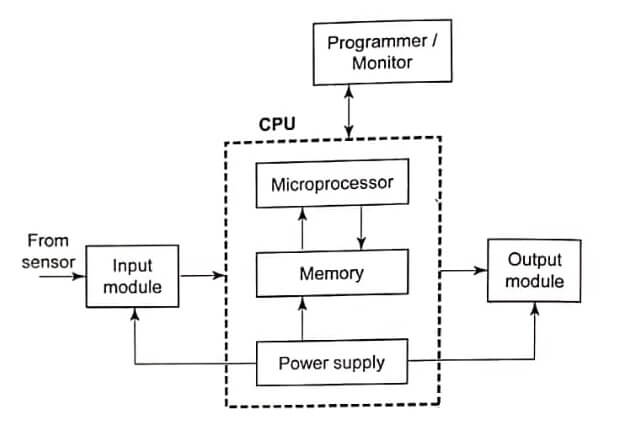The “brain” of the system which has three sub-parts. Central Processing Unit (CPU)
(i) Microprocessor: Microprocessor caries out mathematic and logical operations.
(ii) Memory: The area of the CPU in which data and information is stored and retrieved. It holds the system software and user program.
(iii) Power supply: The electrical supply that converts Alternating Current (AC) line voltage to various operational DC values.

Programmer / Monitor
The programmer/Monitor (PM) is a device used to communicate with the circuits of the PLC. Handheld terminals, industrial terminals and the personal computer exist as PM devices. In a hand-held unit, input takes place through a membrane keypad and the display is usually a Liquid Crystal Display (LCD). With the industrial terminal or personal computer, more complex, type writer keyboards and Cathode Ray Tubes (CRTs) are employed.
Input and Output Modules
The input module has terminals into which outside process electrical signals, generated by sensors or transducers are entered. The output module has terminals to which output signals are sent to activate relays, solenoids, various solid state switching devices, motors and displays.
Central Processing Unit – INPUT/OUTPUT PROCESSING
From the input/output module, we get information in and out of the PLC. The input module terminals receive signals from wires connected to input sensors and transducers. The output module terminals provide output voltages to energize actuators and indicating device.
There are typically 4, 8, 12 or 16 terminals per module. There may be an equal number of input and output terminals for a PLC’s Input/Output modules. More often, however, there are a different number of terminals for input and output; for example, a system module may have 12 inputs and 8 outputs.
In smaller systems, the input and output terminals may be included on the same frame as the central processing unit. In other, larger PLC systems, the input and output modules are separate units.
Typically, upto 256 terminals may be controlled using only 9 to 24 interconnecting wires. The exact number of wires is determined by the type of computer configuration used for terminals to CPU information interchange. The electrical controlling signals from CPU to the Input and Output terminals are coded and decoded electronically, making 256 wires for 256 terminals unnecessary.
Some PLC systems the programming instead of switches to configure Input and Output module settings. Some small systems require no address setting on the Input and Output modules. The order in which you plug the modules in determines the address number for these small systems. Other, larger systems set the address numbers by following a programming procedure on the PM.
Various parts of a programming logic controller (PLC) system require different computer operational rates for proper operation. These rates are called baud rates. A baud is a unit of signaling speed and refers to the number of lines the state (or condition) of a data communication line changes per second. At lower speed, the baud rate and the bits – per second rate are identical. At higher speeds, the baud rate is some fraction of the bits per second rate.
A most important consideration for an Input/Output module is the module’s voltage and current rating. Both voltage and current must match the electrical requirements of the system to which the module is connected. An input module rated at 24 volts DC will not work on 120 volts AC and may even be damaged if the module fuse does not act quickly. An output device requiring 4.5 amperes cannot be turned on by a 2-ampere output module, the module fuse would blow.
Sometimes the processes to be controlled by a PLC are a long distance from the CPU or from each other. The normal input and output electrical signals will be reduced to a value too low for module recognition due to long interconnecting wires. A typical remote set-up is shown in the Figure. The input and output signals from the CPU are coded by an adjacent coding unit into digital electrical pulses.
The pulses are transmitted over wires, or by a fiber optics system to the remote location. At the remote location a matching station decodes the digital signals. The digital pulses are decoded back into the separate signals that feed the remote modules. The signals originally leaving the CPU are, therefore, exactly duplicated at the remote modules a module a mile away will operate as if it were 10 feet away. Other communication systems include telemetering and radio continuous – wave communication.
There is one major precaution to be considered with PLC output modules. In relay operation, when a relay contact is open, there is no current flow in the associated controlled circuit. However, PLC output modules, when turned OFF are not strictly OFF. A small leakage current from the output terminal to the output module still exists, eventhough the output module is turned off. The output current of each module terminal comes from the output of a thyristor semiconductor called a TRIAC.
When not turned ON, the triac still puts out a small amount of current. The leakage current is in the order of a few milliamperes, and is often of no consequence, however the leakage current may have to be considered in some applications. For example, a PLC output terminal might supply a neon bulb that indicates that the output is on, the neon will glow dimly when the module is OFF due to the leakage current.
INPUT MODULES (INTERFACES) – Central Processing Unit
The input module performs four tasks electronically.
- It senses the presence or absence of an input signal at each of its input terminals. The input signals tells what switch, sensor or other signals is ON or OFF in the process being controlled.
- It converts the input signals for high or ON state, to a DC level usable. by the modules electronic circuit. For a low or OFF, input signals, no signal is converted, indicating OFF.
- The input module carries out electronic isolation by electronically isolating the input module output from its input.
- Finally, its electronic circuit must produce an output, via output logic, to be sensed by CPU (PLC).
Figure shows the PLC input module layout. The first block receives the input signal from the switch sensor and so on. For Alternating Current (AC) voltage inputs, the Direct Current (DC) converter consists of rectifiers and a means to step the voltage down to a usable level, usually with a zener diode. For input DC voltages, some type of DC-DC conversion with-in the converter block is required.
The output of the converter is not directly connected to the CPU. For example if a rectifier in the converter should open or short out, you could have 120 volts AC fed to the CPU. Because most CPUs work on only 5 volts DC, they would be damaged. The isolation block protects the CPU from this type of damage.
The isolation is usually accomplished by an optoisolator as shown in the Figure. The ON-OFF signal is carried on a light beam [produced by a light emitting diode (LED)] in one direction. When its input is on, the isolator sends a signal to the CPU via the output logic block. When the isolators output is on, it is sensed by a coded signal from the central processing unit. Each module is assigned a coded series of numbers by its SIP switch settings. Each terminal number of the module is assigned a number in consecutive order. The ON-OFF status for each number is checked on each sweep of the input scan. The result, ON or OFF, is placed in RAM.
Output Modules (INTERFACES)
The output module operates in the opposite manner from the input module as seen in the block diagram of Figure. A DC signal from the CPU is converted through each module section to a usable output voltage, either AC or DC.
A signal from the CPU is received by the output module logic, once for each scan. If the CPU signal code matches the assigned number of the module, the module section is turned ON. The identification numbers of the module are again determined by the setting of the module SIP switches. If no matching signal is received by a terminal during the output scan, the module terminal is not energized.
The matching CPU signals, if received goes through an isolation stage. Again, isolation is necessary so that any erratic voltage surge from the output device does not get back into the central processing unit and cause damage. The isolator output is then transmitted to switching circuitry or an output relay. AC switching is usually performed by turning on a TRIAC.
VARIOUS INPUT AND OUTPUT DEVICES
Commonly used input devices are
Digital / Discrete Input devices:
- Mechanical switches,
- Proximity switches,
- Photo elective switches,
- Encoders,
- Temperature switches, and
- Pressure switches.
Analog Input devices
- Potentiometer,
- Linear variable differential transformer,
- Strain gauges,
- Temperature sensors,
- Pressure sensors,
- Level detector, and
- Flow measurement devices.
The output devices normally used are
- Contactors,
- Directional control valves,
- Motors, and
- Stepper motors.
| Read More Topics |
| Gyroscopic Effect on Naval Ship (or Sea Vessels) |
| Precessional Angular Motion |
| Centrifugal Governors – Principle of Working |
| Forced Vibrations with Harmonic Excitation |






